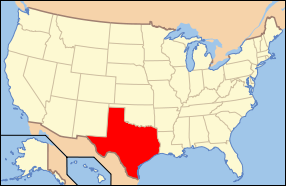Już 62 362 użytkowników uczy się języków obcych z Edustation.
Możesz zarejestrować się już dziś i odebrać bonus w postaci 10 monet.
Jeżeli chcesz się dowiedzieć więcej o naszym portalu - kliknij tutaj
Jeszcze nie teraz ZAREJESTRUJ SIĘlub
Zaloguj »Texas
Temat: Stany Zjednoczone
Do some Exercises: Słuchaj i zapisuj Tworzenie zdań Ukryte słowa
Texas is the second largest state in the United States. It is larger than France. In 1845, it became the 28th state in the United States. Texas has been controlled by Spain, France, and Mexico before declaring its independence from Mexico in 1836. It was its own country, The Republic of Texas, for 9 years.
The largest cities in Texas are Houston, Dallas, Fort Worth, San Antonio, El Paso, and Austin. Austin is the capital city of Texas.
There are many famous attractions in Texas. Fort Worth is known for its stockyards, and Amarillo is known for the cattle business and stockyards. In Dallas, Industrial Technology companies such as Texas Instruments and EDS have their offices.
San Antonio has The Alamo, and Houston has the Johnson Space Center. Austin has The University of Texas at Austin. Texas A&M in College Station and Texas Tech in Lubbock are other important universities in the state.
Geography
Texas is the second biggest state in the Union (after Alaska) and is bigger than every European country except Russia. It has mountains, deserts, plains and coasts. The largest river in Texas is the Rio Grande, which forms the border between Mexico and the United States throughout south Texas. The highest mountain in Texas is Guadalupe Peak.
History
Texas was first explored in 1528 by Spanish explorers on accident (they arrived when their ship sank off the coast). It did not become a colony until 1685, when France claimed it. In response, Spain [[[:0:]]] a rival colony in 1691 by setting up a religious outpost in the eastern part of Texas. Spain did not [[[:1:]]] to Texas until 1716 to protect its colonies in the west from French forces. Two years later, San Antonio was started.
The pressure between the Spaniards and Native Americans in East Texas stopped many settlers from coming to Texas. To stop the violence and the increasing Native American raids, Spain called a truce between many tribes in 1745 and 1789.
Tensions rose in Texas after the United States bought a large amount of nearby land from France in 1803. This land was called the Louisiana Purchase. People began wondering whether Spain or the United States could claim Texas.
When Mexico got independence from Spain in 1821, Texas became part of Mexico. Americans and other settlers came into Texas when Mexico allowed non-Spanish settlers to settle here. After many settlers came to Texas, Mexico started taxing non-citizens. This outraged many settlers. Those from the South were even more outraged because Mexico banned all slavery in 1829 (many southerners saw slavery as a way of life back then). On March 2, 1836, Texas declared independence from Mexico and soon they were at war. Texas won, but Mexico refused to recognize Texas as an independent. Texas soon asked to become a state of the United States. Years later, in 1845, the US added Texas as a state, and Mexico broke off diplomatic relations. Mexico resisted offers by the U.S. to buy land extending from Texas to the Pacific Ocean. In 1846, a dispute over the border between Texas and Mexico resulted in armed conflict, and the Mexican-American War began. The United States won the war, and by the Treaty of Guadalupe-Hidalgo won lands that later formed the states of California, Arizona, Nevada, Utah, New Mexico, southwestern Colorado, and southwestern Wyoming. Mexico received 15 million dollars and gave up its claims to Texas.
After Abraham Lincoln was elected President of the United States, Texas joined the newly formed Confederate States of America in 1861 and fought in the American Civil War in an attempt to become independent from the United States. The Confederates lost to the Union (the United States) in 1865. Texas was restored to full representation in Congress on March 30, 1870.
On January 10, 1901, oil was found in Texas, leading the founding of a richer economy. During a time when the economy was bad, many people left Texas. Texas did not regain its population it lost until the 1950s and 60s. In recent years, Texas has been exploring technology and computers.
Source: wikipedia.org






